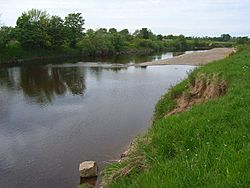Battle of Solway Moss facts for kids
Quick facts for kids Battle of Solway Moss |
|||||||
|---|---|---|---|---|---|---|---|
| Part of Anglo-Scottish Wars | |||||||
 River Esk at Arthuret, near the location of the Battle of Solway Moss |
|||||||
|
|||||||
| Belligerents | |||||||
| Commanders and leaders | |||||||
| Robert, Lord Maxwell, Sir Oliver Sinclair (POW) |
Thomas, Lord Wharton, Sir William Musgrave, John Musgrave |
||||||
| Strength | |||||||
| 15,000–18,000 | 3,000 | ||||||
| Casualties and losses | |||||||
| c. 20 killed; c. 1,200 prisoners; hundreds drowned |
c. 7 killed | ||||||
The Battle of Solway Moss was a fight between English and Scottish armies. It happened in November 1542 near the River Esk. This area is on the English side of the Anglo-Scottish border, close to a wet, marshy area called Solway Moss.
The Scottish King James V was the nephew of King Henry VIII of England. Henry VIII had broken away from the Catholic Church in Rome. He wanted James V to do the same. But James V refused. This made King Henry VIII very angry. He sent his soldiers to attack south-west Scotland.
The Scottish army that went to fight them was not well-organised. Many Scottish soldiers were captured. Others drowned in the river. People believe that the news of this big defeat made King James V die sooner. He passed away shortly after the battle.
Contents
Why the Battle Happened
When King Henry VIII of England started the English Reformation (a big change in religion), he asked his nephew, James V of Scotland, to join him. This meant breaking away from the Roman Catholic Church.
James V did not agree with his uncle. He also upset Henry VIII by not meeting him in York. Henry VIII was furious and sent troops to attack Scotland. To get back at England for this attack, King James V asked Robert, Lord Maxwell to gather a Scottish army. Lord Maxwell was in charge of the Scottish border area called the West March.
The Battle Unfolds
On November 24, 1542, a large Scottish army marched into England. There were between 15,000 and 18,000 Scottish soldiers. Lord Maxwell said he would lead the attack himself.
Some reports say that Oliver Sinclair, a favourite of King James V, tried to take command. But other Scottish leaders refused to follow him. This caused confusion and problems within the Scottish army. However, English commanders like Lord Wharton and Sir William Musgrave reported that Lord Maxwell was still in charge. They said he fought alongside other Scottish nobles.
The Scottish army met Lord Wharton and his 3,000 English soldiers near Solway Moss. The battle was very messy and quickly turned into a defeat for the Scots. Lord Wharton described it as the Scots being completely beaten between the rivers Esk and Lyne.
The Scots found themselves trapped. They were on English land, between the River Esk and a marshy bog called the Moss. After some fighting, they gave up. They also lost their 10 cannons to the English cavalry. Many Scots may have drowned in the marshes and river.
King James V was not at the battle. He was at Lochmaben. When he heard about the defeat, he went to Falkland Palace. He was very upset and sick with a fever. The news that his wife had given birth to a daughter, not a son, made him even sadder. He reportedly said that the Scottish royal family, the House of Stewart, "came with a lass and will go with a lass." He died two weeks later at age thirty.
What Happened After
Only about seven English soldiers were killed in the battle. Around 20 Scottish soldiers died. But about 1,200 Scottish soldiers were captured. Among the prisoners were important leaders like Oliver Sinclair and several Scottish Earls and Lords.
These prisoners were taken to England. Some were later released. But they had to send other people, called "pledges" or hostages, to England in their place. On December 14, 1542, the English Privy Council (a group of royal advisors) ordered that Scottish prisoners entering London should wear a red St Andrew's cross. This was a Scottish symbol.
The Scottish prisoners were generally treated well in England. King Henry VIII hoped that when they returned home, they would support England's plans. Some high-ranking prisoners were exchanged for their pledges in Carlisle on January 10, 1543.
However, the Scottish government sometimes stopped prisoners from returning. They said these prisoners were traitors for losing the battle. Or they thought Henry VIII had influenced them. If their families were arrested in Scotland, these prisoners could not provide pledges. So, they stayed near the border at Berwick-upon-Tweed.
Historians like Marcus Merriman see this battle as the end of King James V's war. It was not the start of Henry VIII's later war, known as the Rough Wooing. The capture of so many Scottish nobles did not change Henry's plans. It also did not stop the Scottish lords from rejecting the Treaty of Greenwich in December 1543.
Remembering the Battle
The battlefield is officially recognized by English Heritage. It is being studied to be protected by Historic Scotland. This is part of their plan to protect important historical sites.
See also
 In Spanish: Batalla de Solway Moss para niños
In Spanish: Batalla de Solway Moss para niños

